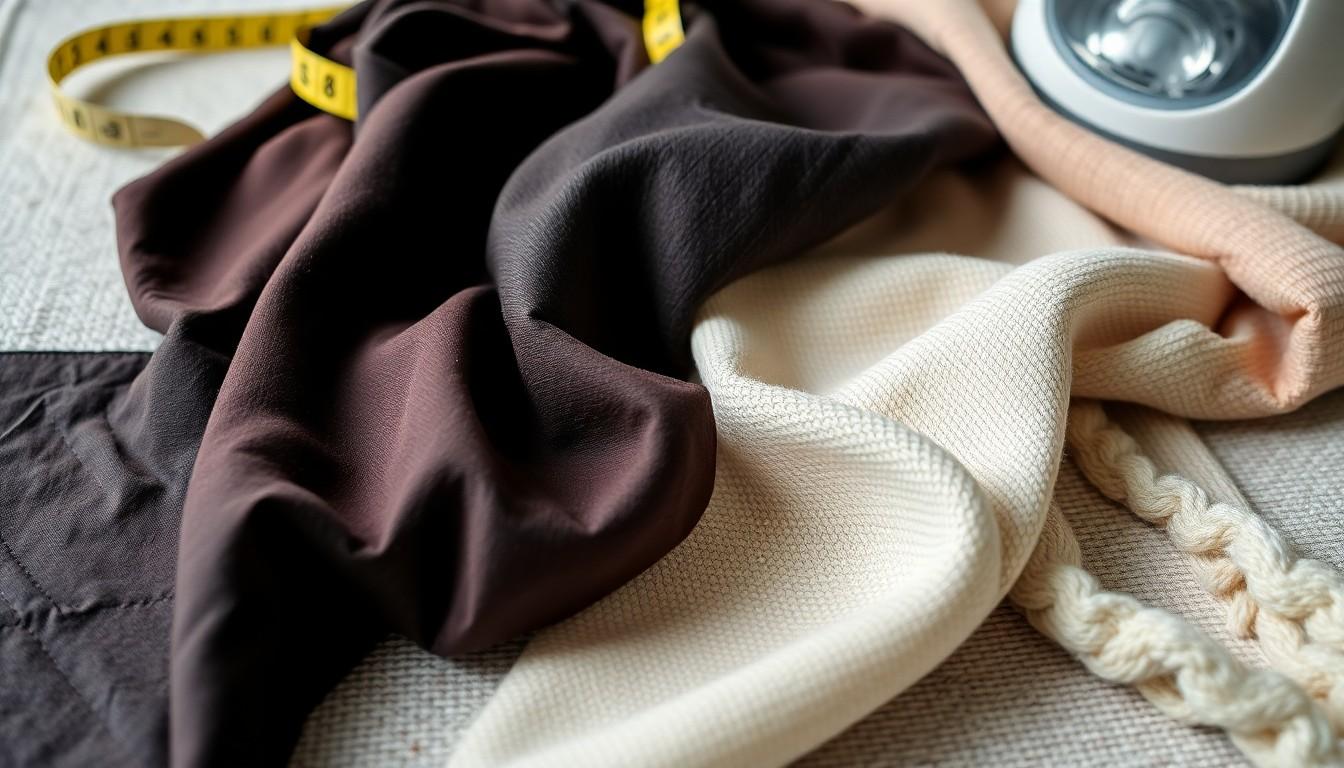We all love the durability and versatility of nylon—it’s a go-to choice for everything from workout gear to outdoor jackets. But when laundry day rolls around we can’t help but wonder: can nylon actually shrink? The answer might surprise you and could change the way we care for our favorite pieces.
Understanding how nylon reacts to washing and drying is key to keeping our clothes looking sharp and fitting just right. If we want to extend the life of our nylon essentials we need to know what really happens when they face heat and water. Let’s jump into the facts and discover how to keep our nylon looking its best.
Understanding Nylon: What Is Nylon Fabric?
Let’s get to know what makes nylon so popular and practical in our closets. We see nylon in a lot of clothing and gear, but there’s more behind its reputation for strength and reliability.
Key Properties Of Nylon Material
Nylon stands out for its impressive toughness. It resists wear and tear better than many natural fibers, so our gear lasts longer. Water tends to bead up on nylon surfaces, making it less likely to absorb moisture and quicker to dry. This material maintains its shape exceptionally well, reducing wrinkles in everything from leggings to windbreakers. Flexibility allows nylon fabric to stretch and move with us, which is why it feels comfortable during intense activity. Lightweight properties let us pack nylon clothing easily, saving space in our bags.
Common Uses Of Nylon In Everyday Life
We find nylon in almost every part of daily life. Jackets and workout clothes often use nylon because it wicks moisture and dries fast. Luggage and backpacks rely on nylon’s strength for extra durability. Umbrellas benefit from nylon’s water resistance, keeping us dry in rain. Carpets and upholstery use its sturdy fibers to withstand heavy use and foot traffic. Parachutes count on nylon’s toughness and flexibility to ensure safety during sports and rescues.
Exploring The Question: Can Nylon Shrink?

Let’s answer the big question: can nylon actually shrink? We’ll walk through what makes nylon shrink and how its behavior stacks up against other popular fabrics.
What Causes Nylon To Shrink?
Placing nylon in hot water or drying it at temperatures above 180°F (82°C) almost always increases the risk of shrinkage. Large amounts of water can also slip between the nylon molecular chains, causing the fibers to contract and the fabric to pull in. Sometimes, changes during manufacturing—like higher melt temperatures, quick cooling, or low packing pressure—set nylon up for more shrinkage once we start using it. Nylon formulas matter too. We’ve seen PA6 shrink by 1%-3%, while PA66 usually shrinks less, at about 0.5%-1.5%. Adding fillers or reinforcements helps the nylon keep its shape, so fabrics with those extras resist shrinking better.
Comparing Nylon Shrinking To Other Fabrics
We notice nylon holds up better than most natural fibers when it comes to shrinking. Cotton and wool, for example, soak up water and can shrink a whole size or more if we’re not careful. Synthetic fabrics like polyester and acrylic behave differently, depending on their properties, but nylon’s moisture resistance usually gives it a slight edge. Mixing nylon with rayon or cotton changes the story—those blends become more prone to shrinking, since rayon and cotton pull in moisture and can drag the whole fabric in with them. Knowing these differences helps us pick the right washing and drying methods for every item in our closet.
| Material | Typical Shrinkage Rate | Water Absorption | Heat Sensitivity |
|---|---|---|---|
| Nylon (PA6) | 1%-3% | Moderate | High |
| Nylon (PA66) | 0.5%-1.5% | Moderate | High |
| Cotton | High | High | High |
| Wool | High | High | High |
| Polyester | Low | Low | Medium |
| Acrylic | Low | Low | Medium |
| Blends (w/ Nylon) | Variable | Variable | Variable |
Factors That Influence Nylon Shrinkage

When we look at what causes nylon to shrink, certain factors stand out more than others. Let’s walk through the key elements that impact shrinkage in our nylon clothing and gear.
Heat Exposure: Washing And Drying Temperatures
Heat plays the biggest role in nylon shrinkage. Once we expose nylon to high temperatures—especially anything above 180°F—those synthetic fibers can tighten up and contract. Hot water in our washing machine or a steamy dryer easily leads to noticeable changes in size. Setting washers and dryers to low or medium heat helps keep nylon’s original shape and fit.
Chemical Interactions: Detergents And Cleaners
Most household detergents don’t directly cause our nylon to shrink. Chemical reactions aren’t usually blamed for changes in fabric size. Still, when we combine a heavy detergent wash with heat and too much moisture, we might see very slight shrinkage. This effect is still driven more by heat and water than by the cleaners themselves.
Mechanical Stress: Agitation And Handling
Every time we tumble, stretch, or stress our nylon items, the fabric faces some physical activity. Agitation in the wash or rough handling isn’t a primary driver for shrinkage, though. Nylon’s structure stands up well to movement. The real influences come from heat and, during manufacturing, factors like wall thickness or cooling speed in molded nylon parts.
| Factor | Direct Impact on Shrinkage | Example in Daily Use |
|---|---|---|
| High heat | Major | Hot dryer, washing in hot water |
| Chemical cleaners | Minor | Strong detergent, bleach |
| Mechanical stress | Minimal | Heavy agitation, stretching by hand |
How To Prevent Nylon From Shrinking

Let’s keep our nylon clothes looking their best by paying extra attention to how we wash and dry them. We’ll show you exactly what steps matter most to avoid shrinkage and preserve the shape of every garment.
Washing Nylon Garments Safely
Sticking with cold or warm water is the safest bet for nylon. Hot water can make nylon fibers contract quickly which causes noticeable shrinkage. We always choose gentle washing cycles because those minimize the stress on the fabric. Mild detergents work best here since they won’t damage or weaken synthetic fibers. It’s a smart move to skip aggressive spin cycles so our favorite workout shirts, jackets, and nylon gear keep their original fit wash after wash.
Proper Drying Techniques For Nylon Fabric
Drying nylon safely means low to medium heat is always the way to go. High heat in the dryer speeds up shrinkage and can permanently alter garment size. We often hang-dry nylon pieces straight from the washer; air drying is much gentler and helps preserve fabric flexibility. If we use a dryer, it’s important to remove clothes as soon as the cycle finishes to stop wrinkles and avoid extra shrinkage. Our go-to approach—keep it cool, skip the heat, and always check labels first for exact care tips.
How To Intentionally Shrink Nylon (If Desired)

Let’s say we actually want our nylon gear a bit smaller—yes, it’s possible. We just need the right temperature, some patience, and a cautious approach to safeguard the fabric and color.
Step By Step Guide To Shrinking Nylon
Start with hot water, since heat is the main trigger for shrinkage. We can wash our nylon items in water around 80 to 100 degrees Celsius for about 10 to 20 minutes. Hot water works by letting molecules inside the nylon contract, which makes the whole garment smaller.
Move on by using a high heat dryer setting after washing. Tossing the fabric into a hot dryer right after the wash increases the shrinking effect. High temperatures force the synthetic fibers to contract, especially after a hot water soak.
Follow up with a gentle air dry or a low heat setting. Cooling nylon gradually after exposing it to heat helps stabilize the smaller size and prevents unwanted warping.
Remember, patience is key throughout the process. We shouldn’t rush any stage because uneven heating or fast drying can cause the fabric to lose its shape.
Things To Watch Out For When Shrinking Nylon
Pay attention to fiber blends in any nylon item we’re shrinking. Blends with cotton or rayon are likely to shrink more than pure nylon since those fibers absorb more water and react strongly to heat.
Notice that a hot wash may also lighten colors or change textures. High temperatures can sometimes fade dyes or make the fabric feel rougher, especially with continued heat exposure.
Consider the physical design of items. Thicker or molded nylon parts will react differently, sometimes shrinking more in certain directions due to manufacturing processes and melt flow.
Avoid going above nylon’s softening or melting point. For example, nylon 6 starts to soften at 149°C, while nylon 6,6 melts at 229°C. Exceeding those can cause irreversible damage and ruin our beloved gear.
Check each area for even heat exposure. Uneven heat can cause jagged proportions or unwanted puckering, so we should always distribute heat as evenly as possible for consistent results.
Dealing With Accidentally Shrunken Nylon

Sometimes even with the best care, we find our nylon garments aren’t fitting quite right after a wash. Let’s talk about straightforward and effective ways we can bring our nylon items closer to their original size.
Tips For Restoring Shrunken Nylon
We want to avoid using any more heat, since extra heat only makes shrinkage worse. Instead, starting with a cold water soak can help—just fill up a sink or tub, immerse the nylon, and let it sit for 15 to 30 minutes. While the fabric’s still damp, we gently stretch it back by hand, working carefully to avoid damaging the fibers. For many, this provides some improvement, though complete restoration isn’t always possible.
Some of us consider professional fabric steaming as a next step, especially for items like nylon dresses or workout gear. Professionals use controlled steam to relax fibers, which can return the fabric closer to its original form without making shrinkage worse.
Whenever we launder our nylon in the future, using low or no-heat drying settings will help prevent more problems. There are also dedicated fabric relaxers and conditioners available, which can soften the fibers and help with stretch recovery. We find these most effective when following the instructions closely and working slowly.
When To Seek Professional Help
If our nylon shrank a lot—say, several inches—or belongs to a specialized item like technical outdoor gear, it’s smarter to get help from a tailor or restoration service. These professionals know how to handle tricky situations and specialty nylon blends that we might damage further at home.
For nylon parts that lost their shape or function (like molded backpack straps or luggage handles), contacting the original manufacturer or a fabric specialist is usually best. Professional advice ensures we don’t risk further damage and gives us the highest chance of restoring fit and function. In every case, asking an expert is the way to go if we have doubts, especially with valuable or irreplaceable items.
Conclusion
Understanding how nylon responds to heat and moisture helps us keep our favorite clothes and gear looking their best. Focusing to washing and drying methods we can avoid unwanted shrinkage and extend the life of our nylon items.
When it comes to caring for nylon blends or tackling accidental shrinkage we’re always better off taking a gentle approach. With a little extra care our nylon garments will stay comfortable and reliable for many seasons to come.
Frequently Asked Questions
Does nylon shrink when washed or dried?
Nylon can shrink when exposed to high heat during washing or drying. Using hot water or a high-temperature dryer cycle increases the risk. To minimize shrinkage, wash nylon in cold or warm water and dry on low to medium heat or air dry.
How much can nylon shrink compared to other fabrics?
Nylon typically shrinks less than natural fibers like cotton or wool. Pure nylon fabrics may shrink between 0.5% to 3%, depending on the type and manufacturing process. Nylon blends with cotton or rayon are more prone to shrinkage due to the other fibers.
What factors cause nylon to shrink?
Heat is the main factor causing nylon to shrink, especially temperatures above 180°F. Prolonged exposure to hot water or high dryer settings can contract the fibers. Nylon is largely resistant to shrinking from detergents or agitation alone.
How can I prevent my nylon clothes from shrinking?
To prevent shrinkage, wash nylon garments in cold or warm water using a gentle cycle and mild detergent. Air dry or use the dryer’s low-heat setting. Promptly remove items after drying to avoid further heat exposure.
Can I shrink nylon on purpose? How?
Yes, you can intentionally shrink nylon by washing it in hot water (80–100°C) and drying it on high heat. Repeat the process if needed but monitor closely to avoid damaging the garment or altering its color and texture.
Is nylon more likely to shrink if blended with other fabrics?
Yes, nylon blends—especially with fibers like cotton or rayon—are more likely to shrink due to those materials’ higher water absorption and shrinkage tendencies. Always check the care label for specific washing instructions.
What should I do if my nylon clothing accidentally shrinks?
If nylon has shrunk, try soaking it in cold water, then gently stretching it by hand while damp. For severe shrinkage, consider professional fabric steaming or take the item to a tailor or garment restoration service.
Will shrinking nylon affect its color or texture?
Shrinking nylon with high heat can sometimes cause color fading or changes in texture, making the fabric feel rougher or less stretchy. Test on a small area first, and avoid excessive temperatures to protect the garment’s quality.
Is mechanical stress from washing or agitation likely to shrink nylon?
No, agitation and handling during washing have minimal impact on nylon shrinkage. The primary concern is exposure to heat, not the mechanical stress from washing machines or hand-washing.







